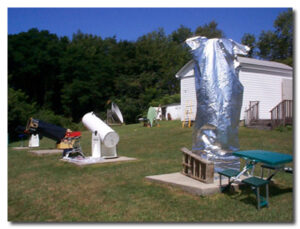 |
Each time when the observatory is opened, there is a sequence of things that we do over the course of the evening. We drive up to the building, unlock the door to the chartroom, and turn on the red lights. We go up to the observing deck and loosen and stow the four turnbuckles which hold the roof in place, and move the 16″ f/6 Newtonian reflector on its German equatorial mount to the horizontal position. We lift the hinged plexiglass window at the south end of the roof to its up position. Then, two hefty fellows pull the roof and roll it open to yield a (hopefully) clear sky as twilight comes to the Darling Hill Observatory. We tilt the ‘scope, set the rolling stairway into place for the evening of observing, and get out the eyepieces. We plug in the clock drive, turn it on, and listen for the soft sound of the sidereal motor, which keeps the stars in the eyepiece field over the course of the evening. And soon we are looking skyward at what the evening holds for us. Then as the stars, galaxies, and clusters emerge into the blackness of the night sky, we observe. We show our guests and visitors the cosmos as magnified through a telescope at the oldest public observatory in Central New York.
Well, that is what we do, but hopefully we remember to do one thing more. We go into the chartroom, find a dusty notebook, and we write in it. That notebook is the Syracuse Astronomical Society’s Darling Hill Observatory Log.
Science is not only the art of observation of the natural world, although that is part of it. True science has the added element of recording those observations so that those who come after us can interpret our data, and then extract from it the principles from which enlarged knowledge of our universe is gained. To do that someone must write down what was observed. Our observatory log is the place those observations are recorded, and that has been so since the founding of our observatory.
Our observatory is not alone in having an observatory log. All observatories have one. I like to visit observatories as I go around the country, and when I do I always look for the log book. I am sure that today the big research facilities do it differently, but originally they all did it the way we do. Someone wrote down the observations in a notebook inside the chartroom near the telescope. I remember going to the great Yerkes Observatory in Williams Bay, Wisconsin where the 40″ Alvin Clark refractor is housed – the largest refractor in the world. It has an observatory log much like ours. There is a feeling of satisfaction in knowing that the fathers of modern astronomy, from William Herschel down to George Ellery Hale and others, recorded their observations in much the same way that we do.
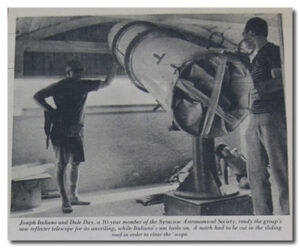 |
From time to time, I will publish in our newsletter some of the history of our observatory based on our logbooks and my memories of the observatory since I arrived in the early 1980s.
The oldest observatory log I have is Log Book #2. On our website is a pdf file which is the scan of the cover and the first 30 pages of that log, covering the period from June 13, 1974 to the end of 1975. My first column here tells that part of SAS history as contained in that log. Look at the original pages of hand-scratched notes, and follow my reading of the history of our observatory.
The first and the last entries are those written by our first observatory director: Joe Italiano. How appropriate! Joe was the driving engine behind the Society’s observatory from the time of its founding through the mid 1990s when he passed the baton of observatory director on to me.
Sadly, many of the notes in the first 30 pages of this log are not of great value, unless one cares about how many times the lawn was mowed at the observatory 35 years ago. But there are a few interesting nuggets there.
There are references in that 1.5-year timeframe to Joe Italiano, Fred Schuelke, Walker Baker, Gunter Wessel, Don Botterin, Winthrop Martin, and Sue Rugelis. They were the stalwarts of the Society and regular observers in those years. I observed with most of them on many occasions over the years, especially Joe, Fred, Gunter, Walker, and Sue. They may now be observing the heavens from a non-earthly perspective (depending on your theology), except for Win Martin, who is still alive but not in good enough health to observe any more. But in their days, they were the ones who regularly pointed the telescope to the skies, and lectured our visitors just as we do today.
On April 19, 1975 there is an intriguing note in the log in the distinctive light pencil printing of Joe Italiano which reads, “Checkout generator – No Current – taking generator back to Lamb for check out.” On November 16, 1974 Joe wrote, “took worn brushes out of the generator.” I do not remember a time when we needed to use a generator to power the observatory, but in the mid-70s there was no electric power to the observatory, and the power for the lights and the clock drive came from a generator and an internal combustion engine. If any of the readers of this column can tell us about that, we would be happy to hear from you.
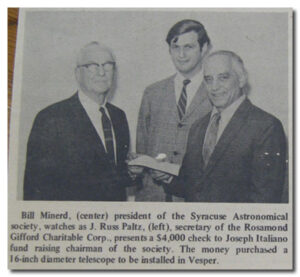 |
Sadly there are few notes on what they did astronomically in that year and a half. A typical note was one unsigned comment (but in the distinctive pencil printing I recognize as that of Joe Italiano) which reads, “10-11-74; Star Party; in 7PM out- 10PM; 15 People; Good Night.” Another evening later that month the log reads, “24 October 74 – W Baker and 15 OCC students of astronomy in 8:00 – out 10:30. Good seeing but a pesky 1st Q moon.” Sure would have been nice if our predecessors wrote down what they looked at in the sky apart from the fact that the moon was in the way of whatever they were observing.
The first actual astronomical object in the log was contained in May 7 and May 9 entries in 1975 by Walker Baker which documented the observation of “NGC 6543” and also the “Saturn Nebula, M11, M17, etc.” I assume they used the 16″ scope for those observations, but there was no description of what eyepiece they used and no description of the object except for a comment about NGC 6543 that reads, “particularly magnificent!” Anyone who has seen that fine planetary nebula (also known as the Cat’s Eye Nebula) in our 16″ scope will certainly agree with Walker’s assessment of it.
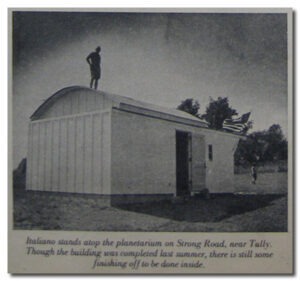 |
Later in May on the evening of the 28th they stayed until they were chased home by the rising moon. Over the evening they observed “Saturn, Venus, Xi Ursa Majoris, M81, M82, M97 (just next to a pair of stars [little sketch] looking like a small Sagitta) and another nebulosity nearby), Alberio, M57, M27, M13, M4 Uranus,” but they could not locate Neptune in the brightening moonlight.
Whatever those early observers lacked in their written records, they made up with their zeal and persistence at the eyepiece. The log shows that in the spring of 1975 they observed on May 7th till 2:30 am, on May 9th till 5:30 am, on May 10th till 1:30 am, on May 14th till 12:30 am, and on May 28th till midnight. 5:30 am!!! When did they sleep?
Even the maintenance log is interesting, since it chronicles the construction of the domed building which thereafter become known as “Building 2.” On August 18, 1975 Joe Italiano and others “layed (sic) out base ring for dome observatory & using as template painted white circle in grass for basic foundation perimeter.” The dome was brought to the property from Syracuse University on September 9, 1975, and the building was constructed during the fall of 1975. Was it finished that year? Well, the record from the log implies that it was. A log entry on November 23rd by Joe Italiano records that “put door frame & doors in new building – help John finish up.” On December 7th Fred Schuelke visited the place, and photographed it, and reports “everything OK. Sunny, clear, cold and snow.”
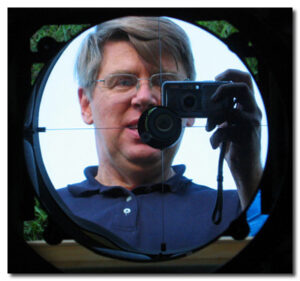 |
Raymond J. Dague is the Observatory Director, long time member, and THE source for observatory instruction and history for the Syracuse Astronomical Society. He can be reached at www.daguelaw.com.
